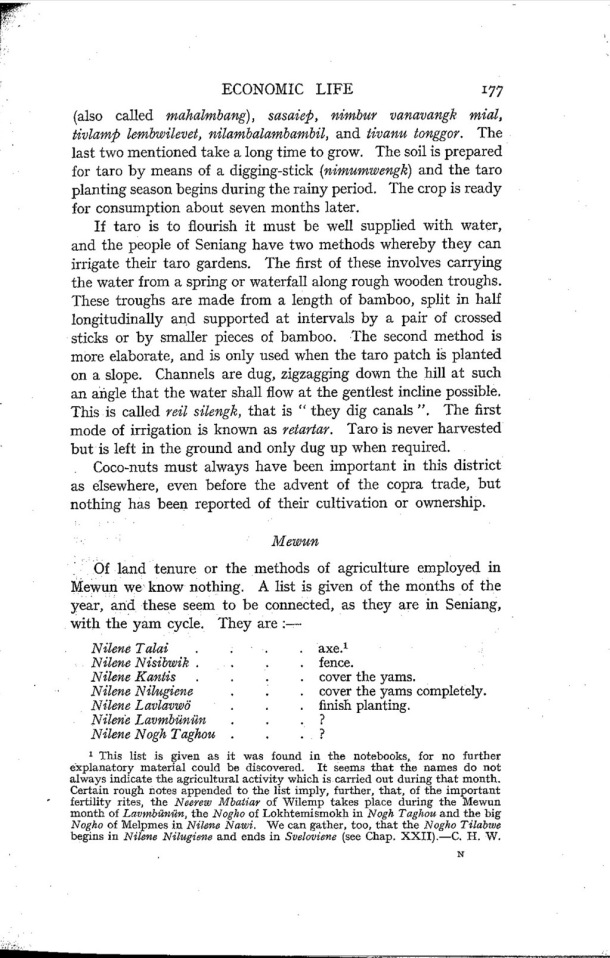|
|  [Note: this transcription was produced by an automatic OCR engine]
ECONOMIC LIFE r77
(also called mahalmbang), sasaiep, wimbur vanavangk mial,
tivlamp lembwilevet, nilambalambambil, and iivanu tonggor. The
last two mentioned take a long time to grow. The soil is prepared
for taro by means of a. digging-stick (nimumwmgk) and the taro
planting season begins during the rainy period. The crop is ready
for consumption about seven months later.
If taro is to flourish it must be well supplied with water,
and the people of Seniang have two methods whereby they can
irrigate their taro gardens. The ï¬Årst of these involves carrying
the water from a spring or waterfall along rough wooden troughs.
These troughs are made from a length of bamboo, split in half
longitudinally and supported at intervals by a pair of crossed
sticks or by smaller pieces of bamboo. The second method is
more elaborate, and is only used when the taro patch is planted
on a slope. Channels are dug, zigzagging down the hill at such
an angle that the water shall flow at the gentlest incline possible.
This is called veil silengk, that is “ they dig canals â€ù. The ï¬Årst
mode of irrigation is known as mfartm. Taro is never harvested
but is left in the ground and only dug up when required.
Coco-nuts must always have been important in this district
as elsewhere, even before the advent of the copra trade, but
nothing has been reported of their cultivation or ownership.
Meimm
' Of land tenure or the methods of agriculture employed in
Mewuri we" know nothing. A list is given of the months of the
year, and these seem to be connected, as they are in Seniang,
with the yam cycle. They are :-
Nilene Talai . . ~ . . axe.‘
Nilims Nisibwik . . fence.
Nilme Kantis . . cover the yams.
Nilenz Nihzgiene . cover the yarns completely.
Nilene Lavlav/wb' . . ï¬Ånish planting.
Nilen}: Laumbiinï¬Ån . . . P
Nilene Nagh Taghou . . . ?
‘ This list is given as it was found in the notalnaooks, for no further
ekplanatory material could be discovered. It seems at the names do not
always indicate the agricultnial activity which is carried out during that month.
Certain rough notes appended to the list imply, further, that, of the important
fertility rites, the Nunw Mbatiav of Wilemp takes place during the Mewun
month of Lmimbcimin, the Nogho Oi Lokhtemismokh in Nogh Tnghou and the big
Nugho of Melpmes i_n Nildw Nizwi. We can GATHER, £00, that the Noglw Tilabu/z
begins in Nilem Ntlugimo and ends in SI/5101/isna (See Chap. XXII).—C. H. W.
. N
i _ _ _ _ _ _7 _
|